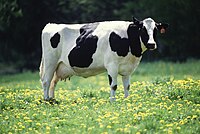
Photo from wikipedia
The aim of this study was to investigate the possible harmful effect of Sarcocystis parasites on bovine diaphragm meat quality. Meat samples were collected from 120 bulls aged 20–24 months.… Click to show full abstract
The aim of this study was to investigate the possible harmful effect of Sarcocystis parasites on bovine diaphragm meat quality. Meat samples were collected from 120 bulls aged 20–24 months. Meat quality was investigated using microbiological and physico-chemical (RP-HPLC, GC) methods 48 hours after slaughter. Sarcocystis infection was associated with increased fat content, lightness L* and drip loss, and decreased ash and protein percentages. Infection also had a significant effect on the amount of amino acids (AAs), which slowly decreased as the number of sarcocysts increased. The total amount of AAs correlated with glutamic acid content (R = 0.966, P < 0.05). Heavily infected samples contained significantly lower amounts of putrescine, histamine, spermine and spermidine (P < 0.05) and a noticeable increase in the total count of aerobic microorganisms, but no change in the numbers of E. coli and coliform bacteria in comparison with no infected samples. Sarcocysts in beef diaphragms did not cause serious changes in the technological quality of the meat, but the biological quality of infected meat was reduced.
Journal Title: Czech Journal of Food Sciences
Year Published: 2018
Link to full text (if available)
Share on Social Media: Sign Up to like & get
recommendations!